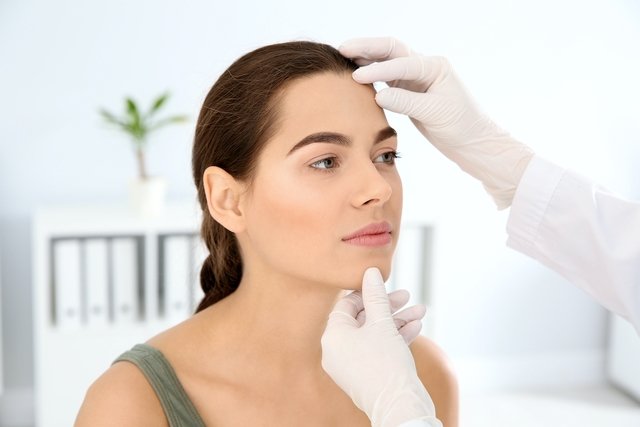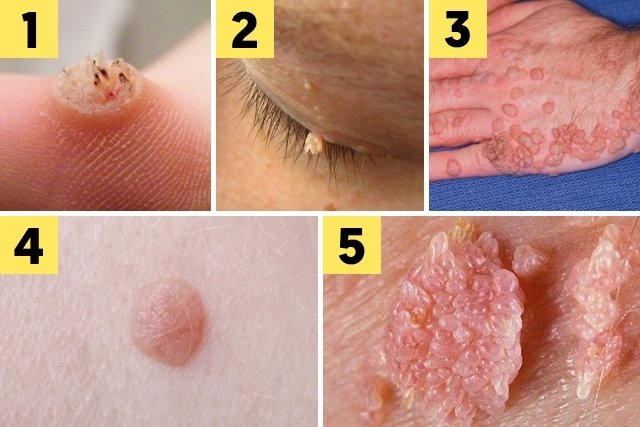Warts are small, generally harmless, benign skin growths caused by the HPV virus, resulting in symptoms such as smooth, rough, flat or raised lesions, with pink, gray, yellowish, brown or black skin color.
Warts can appear in groups or alone, and can easily spread from one area of the body to another, and occur at any age and affect any part of the body, such as the face, foot, groin, genital region or hands. .
Normally, warts disappear without specific treatment, however, the dermatologist may recommend treatment using wart medications to speed up this process, especially when they appear in the genital region.

Symptoms of warts
The main symptom of warts are lesions on the skin, which have characteristics such as:
- Smooth or rough surface;
- Size from 1 to 10 millimeters;
- Flat or have a higher appearance;
- Single or multiple group injuries;
- Skin color, pink, gray, yellowish, brown or black;
- Itching in the area, in some cases;
Furthermore, warts can be dome-shaped, as if it were a semi-sphere, or look similar to cauliflower.
The most common places for warts to appear are hands, feet, face, neck, knees or elbows, but they can also appear in the genital or perianal region.
Despite being benign tumors, it is important to consult a dermatologist to confirm the diagnosis and type of wart, so that the most appropriate treatment can be indicated, if necessary.
How to confirm the diagnosis
The diagnosis of warts is clinical and is made by the dermatologist through physical examination by observing the characteristics of the skin lesions.
Make an appointment with the dermatologist in the region closest to you:
Taking care of your health has never been easier!
Additional tests are generally not necessary, however, if the doctor suspects other conditions with similar symptoms, such as seborrheic keratosis, lichen planus or skin cancer, they may request a skin biopsy. See how a skin biopsy is performed.
Types of warts
Sensitive content
This image may contain content that is uncomfortable for some people.

Warts can be classified into some types according to their location and characteristics:
1. Plantar wart
Plantar warts affect the feet and are popularly known as “fish eye”.
This type of wart is similar to a callus, as it is usually yellowish and has small black dots inside. Learn how to identify plantar warts.
2. Filiform wart
The vulgar wart is a type of wart with a thin and elongated appearance, which appears mainly on the face or neck, and is more common in the elderly.
Read too: Warts on the neck: what they could be (and what to do)
3. Verruca vulgaris
Vulgar or common warts are generally less than 1 cm in diameter, are firm and generally have a rough, rounded or irregular surface and their color can vary from skin color to gray, yellowish, brown or black.
This type of wart is more common in children and adolescents and appears most frequently on the elbows, knees or hands.
4. flat wart
A flat wart is a type of wart that has a flat surface, is soft and measures 1 to 7 millimeters, appearing in groups.
This type of wart is most common on the face, mainly affecting teenagers.
5. Genital warts
Genital warts appear on the vagina, labia majora, shaft of the penis, scrotum or anal region, and are generally soft and pink in color, with a cauliflower appearance, and may be single or appear in groups. Learn how to identify genital warts.
This type of wart, also known as condyloma acuminatum or “rooster’s comb”, occurs mainly as a result of infection with the HPV virus, transmitted sexually through skin-to-skin contact.
Genital warts can also appear in the internal region of the vaginal canal or anus and increase the risk of developing cervical or anal cancer.
Read too: Wart on the penis: what it can be, symptoms (and how to treat it)
Possible causes
Warts are caused by an infection with the HPV virus that infects the epithelial layers of the skin or mucous membranes, where it multiplies and activates the growth of skin cells, causing lesions.
Read too: HPV: what it is, symptoms, transmission and treatment
How to get a wart
Warts are transmitted through direct contact with these lesions, which allows the HPV virus to pass from one person to another. Generally, children are the most affected, as they tend to pick at the warts.
However, it is important to clarify that viruses only cause the appearance of warts when there is some place on the skin that allows them to enter the body, such as a scratch, dry skin, an ingrown toenail or wound, for example.
How to remove warts
There are several types of treatment to remove warts that must be recommended by a dermatologist according to the characteristics and type of wart.
So, some ways to remove the wart are:
1. Use of medicines
The dermatologist may recommend the use of some creams or ointments based on salicylic acid and/or lactic acid that must be applied to the wart and help to eliminate the wart.
These remedies can be applied at home, at least twice a day or as directed by the dermatologist, or in the doctor’s office. See other remedies that may be indicated for warts.
Furthermore, in the case of genital warts, the doctor may recommend the use of ointments, such as imiquimod or podophyllotoxin or the application of acids to the skin, for example.
Read too: 5 treatment options for genital warts
2. Cryotherapy
Cryotherapy is the most commonly used type of treatment to remove warts and consists of freezing the wart through the application of liquid nitrogen spray, which causes the wart to fall off within a few days.
This treatment must be done in the dermatologist’s office to avoid skin burns due to the very low temperature of the liquid nitrogen. Find out more about how cryotherapy is performed.
3. Laser surgery
Laser surgery is recommended when a person has many warts or when they are spread out and is performed under local anesthesia, as the procedure can cause pain and discomfort.
Laser surgery is performed by applying a beam of light directly to the wart with the aim of destroying the wart tissue.
It is important that after laser surgery, the person takes some care with the wound left after removing the wart, as there may be a risk of infection. This recommendation is also important in cases where the doctor cut the wart to remove it, this procedure being called surgical excision.
4. Scotch tape
The duct tape technique is a simple and easy way to remove the wart and is recommended by the American Dermatology Association.
To remove a wart with adhesive tape, it is recommended to place the tape on the wart for 6 days and then remove and immerse the wart in water for a few minutes. Afterwards, a pumice stone or sandpaper should be applied to the area of the wart to remove excess skin. Check out other home techniques to remove warts.
How to prevent
To prevent the risk of contamination with warts, you must:
- Avoid touching other people’s warts without having your skin properly protected with gloves;
- Avoid community swimming pools that are not properly cleaned with specific products;
- Do not share other people’s towels, clothing or underwear;
- Do not share personal objects, such as razors or pliers or nail clippers;
- Avoid biting nails and picking cuticles.
Furthermore, it is also recommended to avoid walking barefoot in swimming pool changing rooms or other public places, using flip-flops whenever possible.
Another way to avoid getting warts is to get the HPV vaccine, which prevents genital warts, precancerous lesions and cancer of the cervix, vulva, vagina or anus. Know where and when to get the HPV vaccine.

Sign up for our newsletter and stay up to date with exclusive news
that can transform your routine!
Warning: Undefined array key "title" in /home/storelat/public_html/wp-content/plugins/link-whisper-premium/templates/frontend/related-posts.php on line 12
Warning: Undefined array key "title_tag" in /home/storelat/public_html/wp-content/plugins/link-whisper-premium/templates/frontend/related-posts.php on line 13



